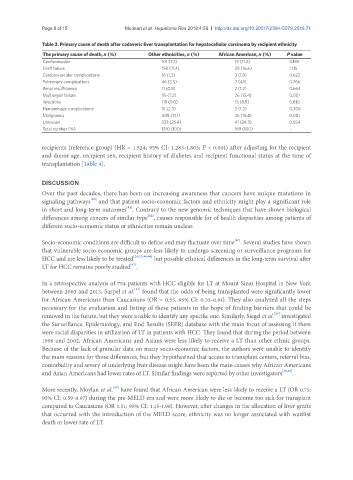Page 603 - Read Online
P. 603
Page 8 of 15 Molinari et al. Hepatoma Res 2018;4:56 I http://dx.doi.org/10.20517/2394-5079.2018.71
Table 3. Primary cause of death after cadaveric liver transplantation for hepatocellular carcinoma by recipient ethnicity
The primary cause of death, n (%) Other ethnicities, n (%) African American, n (%) P value
Cardiovascular 101 (7.7) 19 (11.2) 0.185
Graft failure 150 (11.4) 28 (16.6) 1.115
Cerebrovascular complications 16 (1.2) 3 (1.8) 0.622
Pulmonary complications 46 (3.5) 7 (4.1) 0.766
Renal insufficiency 11 (0.8) 2 (1.2) 0.664
Multiorgan failure 95 (7.2) 26 (15.4) 0.001
Infections 119 (9.0) 15 (8.9) 0.810
Hemorrhagic complications 31 (2.3) 2 (1.2) 0.305
Malignancy 408 (31.1) 26 (15.4) 0.001
Unknown 333 (25.4) 41 (24.3) 0.554
Total number (%) 1310 (100) 169 (100) -
recipients (reference group) (HR = 1.524; 95% CI: 1.283-1.803; P < 0.001) after adjusting for the recipient
and donor age, recipient sex, recipient history of diabetes and recipient functional status at the time of
transplantation [Table 4].
DISCUSSION
Over the past decades, there has been an increasing awareness that cancers have unique mutations in
[40]
signaling pathways and that patient socio-economic factors and ethnicity might play a significant role
[41]
in short and long-term outcomes . Contrary to the new genomic techniques that have shown biological
[42]
differences among cancers of similar type , causes responsible for of health disparities among patients of
different socio-economic status or ethnicities remain unclear.
[43]
Socio-economic conditions are difficult to define and may fluctuate over time . Several studies have shown
that vulnerable socio-economic groups are less likely to undergo screening or surveillance programs for
HCC and are less likely to be treated [24,32,44-46] but possible ethnical differences in the long-term survival after
[47]
LT for HCC remains poorly studied .
In a retrospective analysis of 754 patients with HCC eligible for LT at Mount Sinai Hospital in New York
[27]
between 2003 and 2013, Sarpel et al. found that the odds of being transplanted were significantly lower
for African Americans than Caucasians (OR = 0.55, 95% CI: 0.33-0.91). They also analyzed all the steps
necessary for the evaluation and listing of these patients in the hope of finding barriers that could be
[23]
removed in the future, but they were unable to identify any specific one. Similarly, Siegel et al. investigated
the Surveillance, Epidemiology, and End Results (SEER) database with the main focus of assessing if there
were racial disparities in utilization of LT in patients with HCC. They found that during the period between
1998 and 2002, African Americans and Asians were less likely to receive a LT than other ethnic groups.
Because of the lack of granular data on many socio-economic factors, the authors were unable to identify
the main reasons for those differences, but they hypothesized that access to transplant centers, referral bias,
comorbidity and severy of underlying liver disease might have been the main causes why African Americans
and Asian Americans had lower rates of LT. Similar findings were reported by other investigators [30,48] .
[49]
More recently, Moylan et al. have found that African American were less likely to receive a LT (OR 0.75;
95% CI: 0.59-0.97) during the pre-MELD era and were more likely to die or become too sick for transplant
compared to Caucasians (OR 1.51; 95% CI: 1.15-1.98). However, after changes in the allocation of liver grafts
that occurred with the introduction of the MELD score, ethnicity was no longer associated with waitlist
death or lower rate of LT.

